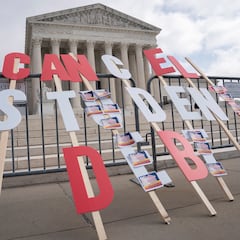What are the requirements to apply for the Biden Administration’s new student debt forgiveness program?
A beta website has been published allowing students to enroll in the new SAVE debt plan and anyone on an IDR plan will qualify.

Not to be stopped by the Supreme Court, the White House announced the new Income-Driven Repayment (IDR) plan, called the Saving on a Valuable Education (SAVE) plan. The concept of the SAVE plan was announced in January, which will replace the Revised Pay As You Earn (REPAYE) plan, is touted as being “the most affordable repayment plan in history.”
The SAVE plan aims to lower monthly payments for borrowers and eliminate them entirely for individuals who meet the income criteria. It will also halt the accumulation of unpaid interest as long as repayments are made promptly.
The Saving on a Valuable Education (SAVE) plan
- For undergraduate loans, cut in half the amount that borrowers have to pay each month from 10% to 5% of discretionary income.
- Guarantee that no borrower earning under 225% of the federal poverty level, about the annual equivalent of a $15 minimum wage for a single borrower, will have to make a monthly payment.
- Forgive loan balances after 10 years of payments, instead of 20 years, for borrowers with original loan balances of $12,000 or less.
- Not charge borrowers with unpaid monthly interest, even when that monthly payment is $0 because their income is low.
What are the requirements to apply?
It is very simple. You simply have to be enrolled in an IDR plan for paying back your student debt. The newly launched beta site will allow borrowers to start submitting applications for the program. You can apply for an IDR if you’re not on one currently and select REPAYE if you want to enroll in the SAVE plan.
For those borrowers who are currently registered under the REPAYE program, the transition to the SAVE program will happen automatically.
The proposed regulations would increase the amount of income protected from repayment from 150 percent of the Federal poverty guidelines to 225 percent. a single borrower earning less than $32,800 would have their monthly payments reduced to zero dollars. The same would be true for a borrower in a household of four with an annual income below $67,500.
The thresholds will be higher in Hawaii and Alaska and those whose income exceeds them could see savings of at least $1,000 per year compared to other IDR plans. This is because under the new plan, the amount that borrowers would be required to pay above the increased level of 225 percent will be half of the most generous IDR plan. Payments on loans borrowed for undergraduate studies will be reduced to just 5% of discretionary income. Those who have both undergraduate and graduate loans will pay a weighted average of between 5 percent and 10 percent of their income based on the original principal balances.
Related stories
To ensure that borrowers enrolled in these repayment plans don’t continue to see their balances grow month after month, the new regulations will stop unpaid interest from accumulating if monthly payments are made. That includes those who qualify for zero-dollar monthly payments.
The SAVE plan will go into effect on July 1, 2024.

